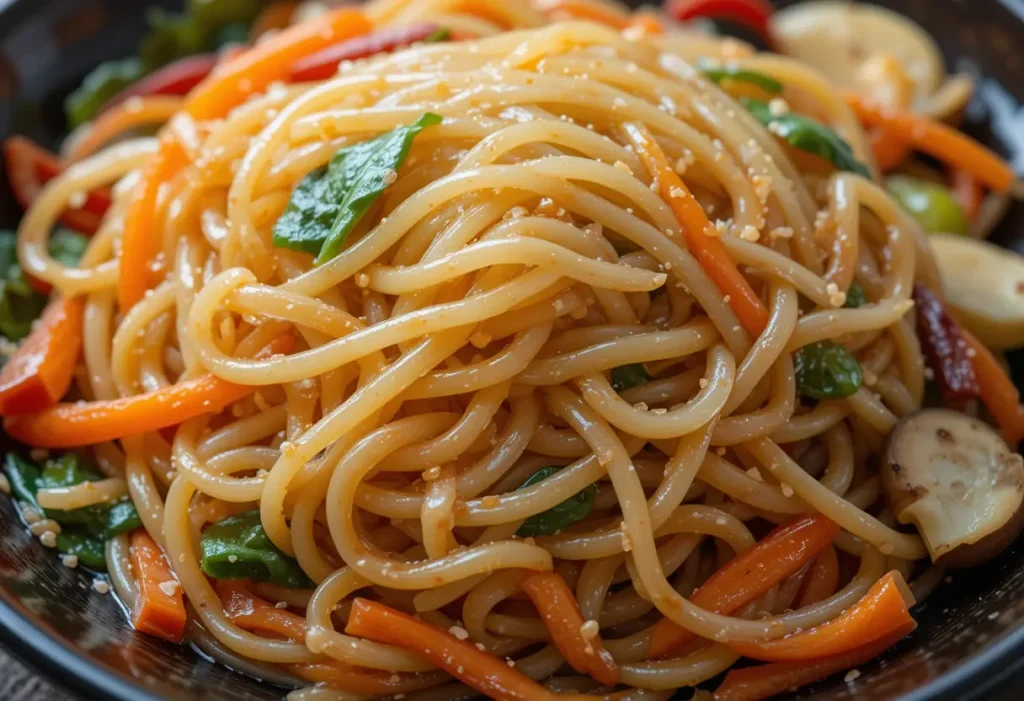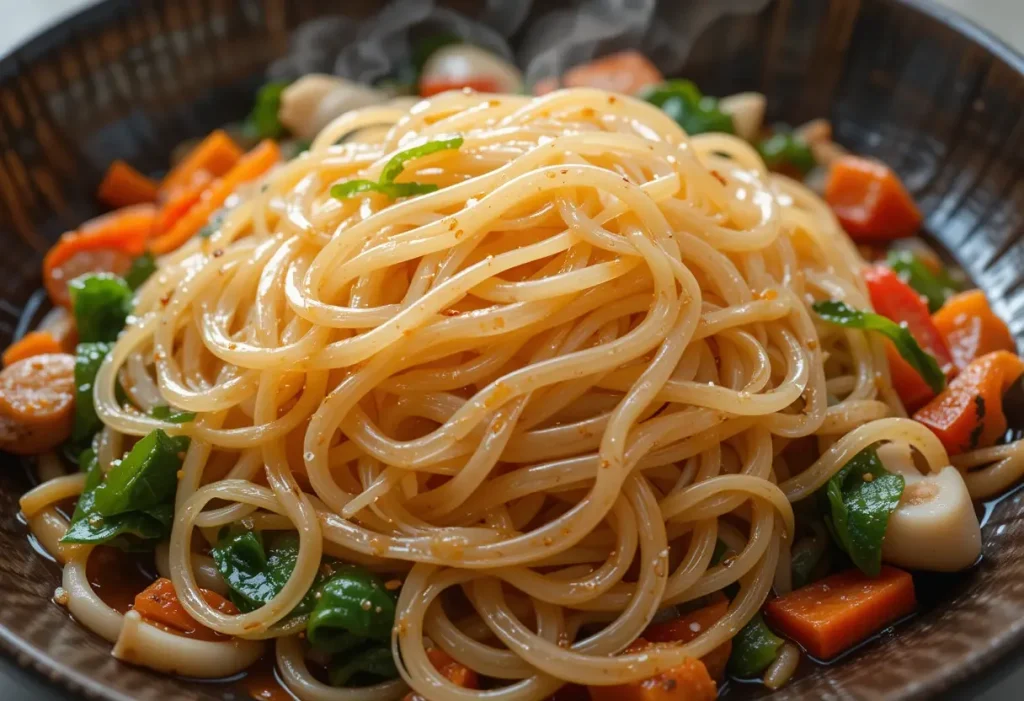Japchae Noodles at Home: Your Quick Ticket to Authentic Korean Flavor

Have you ever craved the rich, savory-sweet flavor of Korean stir-fried noodles but assumed it was too complicated to make at home? Think again. These irresistible Japchae noodles, chewy, glossy sweet potato noodles tossed with vibrant vegetables and umami-rich sauce, are shockingly easy to whip up in under 40 minutes. Whether you’re a K-drama foodie or just looking to spice up your weeknight dinner routine, this recipe brings a taste of Korea straight to your kitchen, with no passport required.
What You’ll Need for Authentic Japchae
Every ingredient brings vibrant flavor and texture. Sweet potato noodles give classic chewiness and a light color. Garlic, soy sauce, and sesame oil create deep umami layers. Carrot, spinach, bell peppers, and onion provide color and freshness. Optional chicken, beef, tofu, or mushrooms add heartiness. Sesame seeds and green onions finish with crunch and aroma.
- 7 oz sweet potato noodles (dangmyeon)
- 2 Tbsp vegetable oil
- 3 garlic cloves, minced
- 1 medium onion, sliced
- 1 medium carrot, julienned
- 1 bell pepper, thinly sliced (any color)
- 2 cups fresh spinach (or 1 cup frozen)
- 3 green onions, chopped
- 3 Tbsp soy sauce
- 1 Tbsp sesame oil
- 1 Tbsp sugar
- Sesame seeds, for garnish
- Optional: 1 cup diced chicken, beef, tofu or mushrooms
Nutrition in Every Noodle Bite
Homemade Japchae is both tasty and nutritious. Sweet potato noodles offer energy and fiber. Vegetables add vitamins, color, and crunch. Protein ups fullness and balance in each serving. Soy sauce and sesame oil bring savory health benefits too. It’s a well-rounded meal you’ll feel good about.
- Calories: 320 kcal
- Protein: 8 g
- Carbs: 52 g
- Fat: 10 g
- Fiber: 4 g
Quick Prep: Timing Breakdown
Prep Time: 20 minutes
Cook Time: 20 minutes
Total Time: 40 minutes
Step-by-Step: Make Flavorful Japchae
Cooking this dish is fun, easy, and rewarding. Each step layers flavor and texture beautifully. Colorful veggies mix with chewy noodles in harmony. A savory soy-sesame sauce ties it all together. It’s a Korean classic made right at home. Follow along and taste your success!
Step 1: Soak the Noodles
Measure and soak sweet potato noodles in hot water. Soak for about 30 minutes until pliable. Drain thoroughly before cooking. Keep noodles separate to avoid clumping. They should be tender but firm.
Step 2: Stir-Fry Veggies First
Heat vegetable oil over medium heat in a skillet. Add garlic and onions, sauté until fragrant. Toss in carrots and bell peppers. Cook until veggies are slightly tender-crisp. Add spinach at the end to wilt. Remove veggies to a bowl.
Step 3: Combine Noodles and Seasonings
Reheat the skillet with a little oil. Add drained noodles and mix gently. Stir in soy sauce, sesame oil, and sugar. Toss until noodles absorb flavors. Return veggies (and protein if using). Stir together for another 3–5 minutes.
Step 4: Add Protein (Optional)
If using meat or tofu, cook it separately. Add cooked protein into noodles mid-way. Toss to heat through and combine flavors. This allows the protein to absorb seasoning nicely.
Step 5: Garnish and Finish

Transfer the Japchae to a serving dish. Sprinkle with sesame seeds and green onions. Mix gently before plating to evenly distribute. Serve warm or at room temperature. Enjoy the harmony of flavors!
Smart Swaps for a Healthier Twist
Want to lighten things up? You can easily swap ingredients. Zoodles or shirataki noodles work instead. Avocado oil is a high-quality oil option. Replace sugar with coconut sugar or skip it. Load more leafy greens like broccoli too. These swaps keep flavor but boost nutrition.
- Use zucchini noodles or whole grain noodles
- Swap vegetable oil for avocado oil
- Replace sugar with coconut sugar or omit
- Add broccoli or cauliflower for variety
How to Serve Japchae Impressively
This dish looks gorgeous and tastes even better. Serve it hot as a main meal. Or cool and use as a colorful side. Wrap it in lettuce for Korean-style fun. Pair with grilled meats or a fried egg. Drizzle a touch of chili oil for a heat kick.
- Serve with grilled chicken, beef, or seafood
- Use in lettuce wraps for casual meals
- Add fried egg and gochujang for a bibimbap twist
- Offer a spicy drizzle of chili oil or paste
Mistakes That Ruin Your Japchae
Even a simple stir-fry needs care. Don’t overcook veggies—they should stay crisp. Cold noodles clump; warm them first. Under-seasoning results in bland noodles. Forgetting sesame seeds loses its nutty finish. Skipping garlic cuts flavor depth.
- Overcooking vegetables makes them mushy
- Stirring in cold noodles causes clumping
- Not seasoning enough = bland taste
- Skipping sesame seeds removes texture and aroma
- Ignoring garlic = shallow flavor profile
Store, Reheat, and Enjoy Japchae
Perfect for meal prep, Japchae stores beautifully. Keep in a sealed container in fridge. Enjoy within 3–4 days for the best quality. Reheat gently with a splash of water or soy sauce. Freezing affects texture; refrigeration is best. Prepping noodles ahead saves cooking time later.
- Refrigerate leftovers in an airtight container (3–4 days)
- Reheat with a bit of water or sauce
- Prep veggies/noodles a day ahead to speed cooking
- Avoid freezing for ideal texture
Why You’ll Love This Homemade Japchae
This Japchae blends vibrant veggies and chewy noodles beautifully. It’s authentically Korean, yet doable at home. Balanced flavors, texture, and color in every bite. You’ll impress friends or enjoy solo comfort. Easy to customize and meal prep. It’s a go-to recipe worth mastering.
Conclusion
With its glossy noodles, colorful vegetables, and signature Korean flavors, Japchae noodles are more than just a dish; they’re a celebration of balance, simplicity, and comfort. Whether you enjoy them warm or cold, on their own or with your favorite protein, this easy homemade version proves that delicious Korean food doesn’t have to mean takeout. Try it once, and it just might become your new weekly favorite. Ready to bring a little Seoul to your table?

